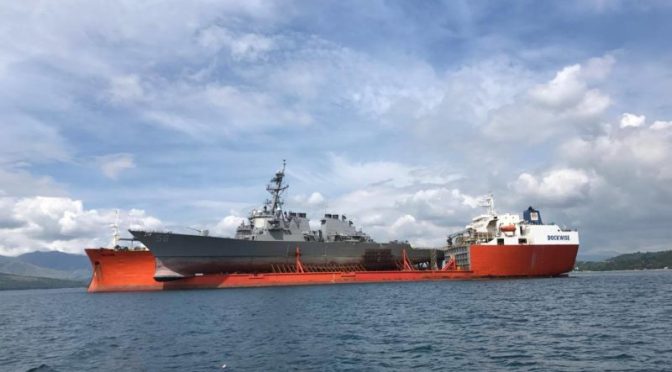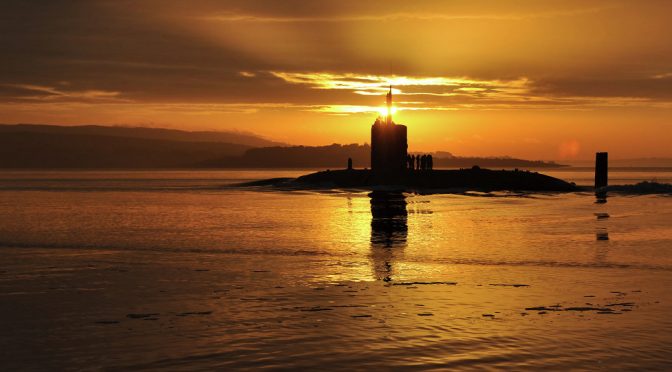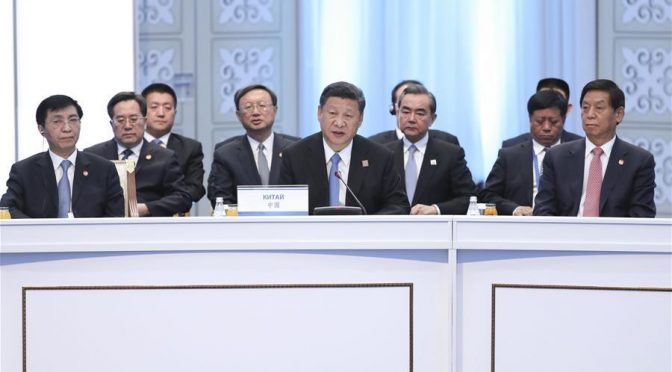CIMSEC is committed to keeping our content FREE FOREVER. Please consider donating to our annual campaign now so we can continue to provide free content.
By Dmitry Filipoff
This year CIMSEC was privileged to publish numerous articles on maritime security and defense and foreign policy topics. These pieces below were chosen based on how well they were received by the CIMSEC readership and their especially insightful contributions in advancing the dialogue on maritime security. The following list is by no means as comprehensive as we could hope for given the high quality our contributors maintained year-round, and the articles are not listed in any particular order or ranking.
Thank you as always for your readership and contributions. See you in the new year!
Standing up the NIWDC with CAPT John Watkins by Sally DeBoer
“At the NIWDC, in partnership with IFOR, this is one of our tasks – to perform this DOTMPLF analysis that will codify the IWC construct. We’ve been tasked by Fleet Forces Command and PACFLT to do just that – this will be one of our top objectives in the first years here at the NIWDC – to ensure we’re setting ourselves up for success for decades to come.”
Hainan’s Maritime Militia: All Hands on Deck for Sovereignty Pt. 3 by Conor M. Kennedy and Andrew S. Erickson (See full series here)
“The maritime militia units of Sanya, Danzhou, Tanmen, and Sansha should not be seen in isolation, but rather as elements of the Hainan MD militia force system. Directed by national militia construction guidelines and a highly publicized visit by paramount leader Xi Jinping to the Tanmen Maritime Militia, every other county in Hainan Province has established singular or multiple maritime militia units.”
The Role of the Black Sea in Russia’s Strategic Calculus by Byron Chong
“For Russia to achieve these long-term objectives, its supremacy in the Black Sea is a critically enabling factor. The unique geography of the region confers several geopolitical advantages to Russia in its confrontation with the West. As such, the Kremlin has sought measures to strengthen its hold over the region.”
Design Thinking for Military Advantage in collaboration with U.S. Fleet Forces Command (USFFC) and Navy Cyber Defense Operations Command (NCDOC)
“What if the Navy fostered an environment wherein the creative problem solving, critical thought, and extreme ownership that called these legends to action were core competencies across the force? Imagine a force that spends less time prescribing exactly what to do and instead harnesses the power of the collective, a force where our competitive advantage is not simply people, but rather capable, empowered, and passionate teammates.”
The Evolution of Chinese Debates on Maritime Strategy Pt. 1 by Sherman Xiaogang Lai (Pt. 2 here)
“As Chinese research institutions are behind the changes, a review of the evolution of debates reveals some dynamics and developments within China’s research institutions. It would therefore help us understand China’s current security dilemma in maritime affairs and Chinese researchers’ intellectual restraints in finding solutions to the dilemma.”
Strategy and Ship Design – History’s Lessons for Future Warship Concepts by Harry Halem
“New technologies may change the way wars are fought at the tactical and operational level, but policymakers and naval officers must organize those developments under a broader umbrella to understand their true application and effects. History demonstrates the need to understand strategy, and a service’s role in that strategy, when modernizing a military force.”
Reagan-Era Navy Secretary John Lehman on Naval Recapitalization by Dmitry Filipoff
“Have a sound strategy, and stick to it. Have a robust but achievable force goal. Cut costs and increase competition everywhere you can. Balance and adjust the fleet among all its competing missions, regions, and levels of conflict, and above all, ensure the capability to deter or defeat the most dangerous potential enemies of our nation.”
China: Connected Strategic Themes Across Global Commons Pt. 1 by Tuan Pham (Pt. 2 here)
“In Part 1 of this two-part series, I explore this potential cross-domain nexus by examining the latest Chinese space white paper and cyberspace strategies. In Part 2, I will derive possibly connected strategic themes that cut across the interlinked global commons and discuss how the United States could best respond.”
Sea Control 127 – Dr. Tom Fedyszyn on Russian Navy Ops, Acquisition, and Doctrine by Ashley O’Keefe
“I’ll make the case that starting around 2008, the Russian Navy began to get money, they began to get smart, they began to get joint, and they began to operate again. So today, pretty much anywhere, you can find ships of the Russian Navy.”
The Battle of Locust Point: An Oral History of the First Autonomous Combat Engagement by David R. Strachan
“The following classified interview is being conducted per the joint NHHC/USNI Oral History Project on Autonomous Warfare. This is the first of an eight-part series with Admiral Jeremy B. Lacy, USN (Ret), considered by many to be the father of autonomous undersea warfare, where we discuss the development of the Atom-class microsubmarine, and its role in the first combat engagement of the autonomous era, the Battle of Locust Point.”
Why Are Our Ships Crashing? Competence, Overload, and Cyber Consideration by Chris Demchak, Keith Patton, and Sam J. Tangredi
“In directing a pause for all warship crews (not currently conducting vital missions) during which to conduct assessments and additional training, the Chief of Naval Operations – Admiral John Richardson – was asked whether the Navy was considering cyber intrusion as a possible cause. The CNO responded that concerning cyberattack or intrusion, ‘the review will consider all possibilities.’”
Reforming 21st Century Navy Intelligence to Answer the CNO’s Call by Millard Bowen and Dave Andre
“Navy IC-led international partnerships and information sharing will provide new levels of access to intelligence, facilities, and new technology in this era of increased globalization. These changes will not happen immediately, they will require adaptation, ingenuity and a cultural shift.”
French Maritime Strategic Thought on the Indo-Pacific by David Scott
“In Europe, France is distinctive in claiming that its boundaries actually extend outside Europe into the Indian Ocean and Pacific Ocean, i.e. the ‘Indo-Pacific,’ through its overseas departments (département d’outre-mer), and overseas territories (territoire d’outre-mer), which are considered integral parts of France, and indeed thereby of the European Union. These Indo-Pacific possessions also have large Exclusive Economic Zones (EEZs). These give France important maritime interests to be maintained, and if need be defended, by the French Navy.”
Pitfalls in New Capital Ship Creation by Steve Wills
“These classes were overtaken by further perturbations in the same three categories that were responsible for their initial creation and their reign as “capital ships” was brief. A study of these less-than-successful capital ship entrants is useful in predicting the emergence of the “next” capital ship.”
Admiral Scott Swift on Leadership, Risk, and a Life in the U.S. Navy by Chris Nelson
“Anytime you are a leader in the military – or leader of any organization – there is more uncertainty than certainty in the decisions you face. And yet I struggled for a long time looking for words to describe that uncertainty in a broader context.”
History’s Data for Tomorrow’s Navy by Frank A. Blazich, Jr.
“The advent of digital computing has vastly transformed record generation and retention, both of which pose notable challenges to records management.5 In a period of important fiscal and strategic decisions, the Department of Defense and the Navy must consider a cultural and institutional revival to collect and leverage data for potential catalytic effects on innovation, strategic planning, and warfighting advantages.”
Minding the Interoperability Gap by Tim McGeehan and Douglas Wahl
“While it has allowed the U.S. to maintain military primacy for decades, the technical capabilities of many allies and partners now lag far behind, raising concerns about the gap’s impacts on interoperability. This gap can drive critical tactical and operational decisions on where, when, and how forces are employed in a multinational environment, often with political ramifications.”
USNS Dreadnought: A Combat Logistics Force for the 21st Century by Chris O’Connor
“A successful future U.S. Navy will be comprised of innovatively designed combatants, with arsenals of new weaponry, employing cyberwarfare and unmanned systems to an extent that we can barely conceptualize now. They will still need a capital-ship level of investment in an interconnected web of logistics assets to fight against a peer adversary. The toilet paper, Diet Pepsi, and turbolaser parts have to come from somewhere.”
Sea Control 140 – The U.S. Coast Guard with Admiral Charles Michel by Matthew Merighi
“And we’re a unique agency that operates in the whole threat spectrum from symmetric actors, to terrorists, to criminals, to regulator violations to mom-and-pop boaters getting in trouble, to natural disasters, hurricanes, earthquakes, and oil spills. All with 40,000 people, smaller than the New York Police Department.”
A Cyber Vulnerability Assessment of the U.S. Navy in the 21st Century by Travis Howard and José de Arimatéia da Cruz
“This paper presents a high-level, unclassified overview of threats and vulnerabilities surrounding the U.S. Navy’s network systems and operations in cyberspace. Several threats are identified to include nation states, non-state actors, and insider threats. Additionally, vulnerabilities are presented such as outdated network infrastructure, unique networking challenges present aboard ships at sea, and inadequate operating practices.”
Dmitry Filipoff is CIMSEC’s Director of Online Content. Contact him at Nextwar@cimsec.org.
Featured Image: HMS Triumph comes into a naval base on the River Clyde (AP)




